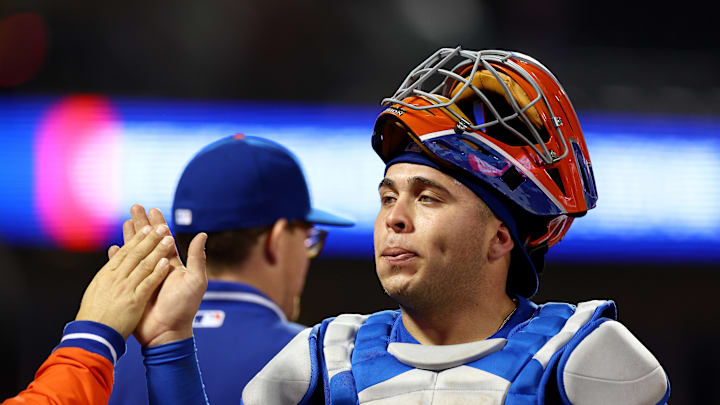The New York Mets entered the offseason with many holes to fill. Among all the positions, one already crowded turned out to be a big headache this year, the catching position. This position combined last year to produce just 7 HRs and 55 RBI with a .216 AVG and a terrible OPS of just .568.
To try to improve at the position, the Mets signed catcher Omar Narváez and traded James McCann to the Orioles. That leaves the team with three options for catching, two defense-oriented catchers in the figure of Narváez and Nido, and their top prospect, Francisco Álvarez.
How the Mets should use Omar Narváez
Narváez seems poised to be the New York Mets' primary catcher entering the year. He's been a more promising catcher in terms of offensive while being very close or similar to Nido in defensive framing. You can see this by looking at their respective fWAR where Narváez finished with a 1.1 in 2022 versus the 0.9 from Nido. All this by taking into account that 2022 was a regression offensively for Omar.
On the offensive side, Narváez did not have a great year in 2022, hitting for a .206 batting average with just 4 HR and 23 RBI in 84 games. However, a year earlier (2021) he showed a good approach at the plate with a batting line of .266/ .342/.402/.743 with a wRC+ of 100 and a wOBA of .322. In addition, he has been a good hitter against right-hander pitchers his entire career showing a batting average of .268 in his seven years of service.
But one of the things Narvaez has improved the most in recent years has been his defense. Before 2020, Omar was an average defender experiencing trouble with framing. Now three later, after working with Manny Piña in Milwaukee, Narvaez is cataloged as a high-ranking framing catcher, where he has been #1 in framing between 2020-2021 and #7 in 2022.
On the other hand, a weakness in Narváez's game is his hard-hit contact which turns out to be mediocre. He should shift his approach at the plate by increasing his z-contact and limiting o-contact, especially the latter which increased from 56.3% in 2021 to 68.9% in 2022. This is especially important since the probability that a contact outside of the strike zone generates a low exit velocity of the ball is high.
How the Mets should use Tomás Nido
Nido has always been a great game-caller and has his most value as a defense-first catcher. In his six years in the Mets organization, he has been used as a backup catcher most of the time, with 2022 being the year in which he earned the most behind-the-plate appearances with 98 games.
He has been praised by Mets pitchers as a great communicator been the preferred choice in the past of Jacob deGrom, Noah Syndergaard, and others. This could be proven by looking at his defensive metrics in which he is one of the best framing catchers in the game ranked #10 in 2022. He also ranks well in the 60th percentile in Pop time (this stat measure how quickly the catcher releases the ball, measured in seconds, and arm strength).
In terms of offensive production, Nido hasn't been a very productive catcher in his career, hitting just .220 with a .323 SLG. But he has been a good hitter against left-handed hitters batting .245 over his MLB tenure with a career-high of .259 last season.
Ok, so what should the Mets do with Francisco Álvarez?
Finally, Francisco Alvarez. He's not only the Mets top prospect but the best prospect of all MLB, according to MLB Pipeline. Alvarez is well known as a power hitter with elite bat speed and patience at the plate.
He was called up last year ahead of the most important series for the Mets versus Atlanta on September 30. Since then, he got 14 plate appearances batting only two hits, one of them a home run.
While Alvarez has the highest ceiling of any Mets catcher in terms of offensive production, his defensive side is still developing. In a rotation that includes two future Hall of Famers, Álvarez's adjustment as a game-caller could take time, he must create a relationship with established pitchers from scratch, an aspect that requires patience and the Mets are not in the wait-and-see position.
Moreover, calling up your top prospect to give him only partial or marginal playing time at a position like DH would limit his development by holding back his potential.
Looking at all of the above, the best way to handle the catcher position for the Mets is to use Narváez and Nido in split time, using Narváez against right-handed pitching and Nido against left-handed ones. On the other hand, Álvarez's development requires him to see as enough playing time as possible as he continues to improve. He could be called up later in the year and play more competitively, contributing as a designated hitter and occasionally catching if necessary.
